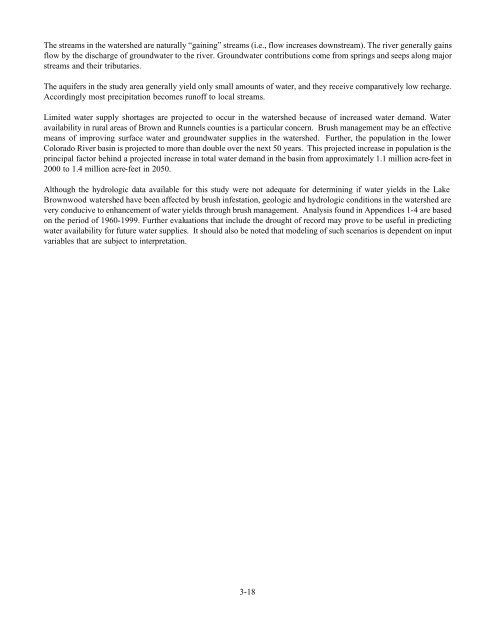Lake Brownwood Watershed - Texas State Soil and Water ...
Lake Brownwood Watershed - Texas State Soil and Water ...
Lake Brownwood Watershed - Texas State Soil and Water ...
You also want an ePaper? Increase the reach of your titles
YUMPU automatically turns print PDFs into web optimized ePapers that Google loves.
The streams in the watershed are naturally “gaining” streams (i.e., flow increases downstream). The river generally gains<br />
flow by the discharge of groundwater to the river. Groundwater contributions come from springs <strong>and</strong> seeps along major<br />
streams <strong>and</strong> their tributaries.<br />
The aquifers in the study area generally yield only small amounts of water, <strong>and</strong> they receive comparatively low recharge.<br />
Accordingly most precipitation becomes runoff to local streams.<br />
Limited water supply shortages are projected to occur in the watershed because of increased water dem<strong>and</strong>. <strong>Water</strong><br />
availability in rural areas of Brown <strong>and</strong> Runnels counties is a particular concern. Brush management may be an effective<br />
means of improving surface water <strong>and</strong> groundwater supplies in the watershed. Further, the population in the lower<br />
Colorado River basin is projected to more than double over the next 50 years. This projected increase in population is the<br />
principal factor behind a projected increase in total water dem<strong>and</strong> in the basin from approximately 1.1 million acre-feet in<br />
2000 to 1.4 million acre-feet in 2050.<br />
Although the hydrologic data available for this study were not adequate for determining if water yields in the <strong>Lake</strong><br />
<strong>Brownwood</strong> watershed have been affected by brush infestation, geologic <strong>and</strong> hydrologic conditions in the watershed are<br />
very conducive to enhancement of water yields through brush management. Analysis found in Appendices 1-4 are based<br />
on the period of 1960-1999. Further evaluations that include the drought of record may prove to be useful in predicting<br />
water availability for future water supplies. It should also be noted that modeling of such scenarios is dependent on input<br />
variables that are subject to interpretation.<br />
3-18



